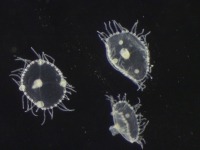
(Photo: Huntsman Marine Science Centre)
Bushy Wineglass Hydroid or Thread Hydroid
Obelia sp.
The body of the sea jelly-like medusa stage is a flat circle with many tentacles emerging from the perimeter. The stomach is a large dark spot in the centre, and four round gonads sit around the mouth. The medusa forms of the different species are indistinguishable. The medusa is approximately 2.5 to 6 millimetres wide. The polyp stage appears as a tree-like, branching organism attached to the seabed. There are cups at the end of the branches where medusa develop and emerge. The polyp stage can be up to 25 centimetres long.
Authority
Peron & Lesueur, 1810
Classification Details
Phylum: Cnidaria (Cnidarians); Class: Hydrozoa (hydrozoans).
Habitat
Very widespread. Found in many areas over the North Atlantic Ocean. Various species are also found in Europe as well as in the Pacific Ocean and South Atlantic Ocean. The polyp stage is benthic, and the medusa stage is planktonic. The polyp stage attaches to a substrate such as rocks, molluscs, or seaweed. It uses thread-like roots called hydrorhiza.
Diet
Predator. Polyps capture small food from the water using stinging cells (nematocysts) on their tentacles to paralyze prey. The medusa stage eats bacteria and small larvae of other invertebrates. They brush food towards the mouth with movements of the bell and tentacles. They also paralyse prey using nematocysts like the polyps.
Reproduction
Polyps reproduce asexually by budding. The medusae have separate sexes and undergo sexual reproduction. They release eggs and sperm into the water, where the sperm fertilizes the eggs. A free-swimming larval form develops and settles on a substrate and becomes a polyp. It can then undergo asexual reproduction to create a colony.
Fun Facts
We call these hydroids "sea-fur" due to the branched, hairy, appearance of the polyp form.
References
Boero F, Bucci C, Gravili C and Stabili L (2007) Obelia (Cnidaria, Hydrozoa, Campanulariidae): A microphagous, filter-feeding medusa. Marine Ecology 28, 178–183. van Couwelaar M (2003) Obelia spp. Zooplankton and micronecton of the North Sea. Accessed on Marine Species Identification Portal http://species-identification.org/species.php?species_group=zmns&id=231 Accessed online 22 January 2020. Schuchert P (2020) World Hydrozoa Database. Obelia Péron & Lesueur, 1810. Accessed through: World Register of Marine Species at: http://www.marinespecies.org/aphia.php?p=taxdetails&id=117034 Accessed online 22 January 2020. Van Guelpen L, Pohle G, Vanden Berghe E and Costello MJ (2005) Marine Species Registers for the North Atlantic Ocean. World Wide Web electronic publication. http://www.vliz.be/vmdcdata/narms/

